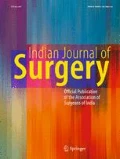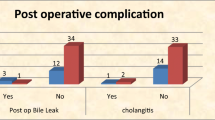Abstract
Bile duct injury following cholecystectomy is an iatrogenic catastrophe associated with significant perioperative morbidity, reduced long-term survival and quality of life. There has been little literature on the long-term outcomes after surgical reconstruction and factors affecting it. The aim of this study was to study factors affecting long-term outcomes following surgical repair of iatrogenic bile duct injury being referred to a tertiary care centre. Between January 2005 to December 2011, 138 patients with bile duct injury were treated in a single surgical unit in a tertiary care referral hospital. Preoperative details were recorded. After initial resuscitation, any intra-abdominal collection was drained and an imaging of biliary anatomy was done. Once the general condition of the patient improved, patients were taken up for a side-to-side extended left duct hepaticojejunostomy. The post-operative outcomes were recorded and a hepatobiliary iminodiacetic acid scan and liver function tests were done, and then the patients were followed up at regular intervals. Clinical outcome was evaluated according to clinical grades described by Terblanche and Worthley (Surgery 108:828–834, 1990). The variables were compared using chi-square, unpaired Student’s t test and Fisher’s exact test. A two-tailed p value of <0.05 was considered significant. One hundred thirty-eight patients, 106 (76.8 %) females and 32 (23.2 %) males with an age range of 20–63 years (median 40.8 ± SD) with bile duct injury following open or laparoscopic cholecystectomy, were operated during this period. Majority of the patients [83 (60.1 %)] had a delayed presentation of more than 3 months. Based on imaging, Strasburg type E1 was seen in 17 (12.5 %), type E2 in 30 (21.7 %), type E3 in 85 (61.5 %) and type E4 in 6 (4.3 %). On multivariate analysis, only level of injury, longer duration of referral and associated vascular injury were independently associated with an overall poor long-term outcome. This study demonstrates level of injury at or above the confluence; associated vascular injury and delay in referral were associated with poorer outcomes in long-term follow-up; however, almost all patients had excellent outcome in long-term follow-up.
Similar content being viewed by others
References
Davids PH (1993) Bile duct injury after laparoscopic cholecystectomy: the value of endoscopic retrograde cholangiopancreatography. Gut 34:1250–1254
Jabłońska B, Lampe P (2009) Hepaticojejunostomy vs. end-to-end biliary reconstructions in the treatment of iatrogenic bile duct injuries. J Gastrointest Surg 13:1084–1093
Terblanche J, Worthley CS (1990) High or low hepaticojejunostomy for bile duct strictures? Surgery 108:828–834
Strasberg SM, Hertl M, Soper NJ (1995) An analysis of the problem of biliary injury during laparoscopic cholecystectomy. J Am Coll Surg 180:101–125
Flum DR, Cheadle A, Prela C, Dellinger E, Chan L (2003) Bile duct injury during cholecystectomy and survival in medicare beneficiaries. JAMA 290(16):2168–2173
Jarnagin WR, Blumgart LH (1999) Operative repair of bile duct injuries involving the hepatic duct confluence. Arch Surg 134:769–775
Jabłońska B, Lampe P, Olakowski M, Lekstan A, Górka Z (2008) Surgical treatment of iatrogenic biliary injuries—early complications. Pol J Surg 80:299–305
Pitt HA (2001) Surgical therapy of iatrogenic lesions of biliary tract. World J Surg 25:1360–1365
Hepp J, Couinaud C (1956) Approach to and use of the left hepatic duct in reparation of the common bile duct. Presse Med 64:947–948
Lubikowski J (2011) Surgical management and outcome of bile duct injuries following cholecystectomy: a single-center experience. "Langenbeck's Archives of Surgery 396:699–707
Stewart L, Way L (1995) Bile duct injuries during laparoscopic cholecystectomy: factors that influence results of treatment. Arch Surg 130:1123–1128
Stewart L, Way L (2009) Laparoscopic bile duct injuries: timing of surgical repair does not influence success rate. A multivariate analysis of factors influencing surgical outcomes. Arch Surg 11(6):516–522
de Reuver PR, Irene G, Olivier R (2007) Referral pattern and timing of repair are risk factors for complications after reconstructive surgery for bile duct injury. Ann Surg 245(5):763–770
Olsen D (1997) Bile duct injuries during laparoscopic cholecystectomy. Surg Endosc 11:133–138
Heise M (2003) Management of bile duct injuries following laparoscopic cholecystectomy. Zentralbl Chir 128:944–951
Jukka K, Salminen P (2011) Bile duct injuries during open and laparoscopic cholecystectomy in the laparoscopic era: alarming trends. Surg Endosc 25(9):2906–2910
Yuhsin V (2010) Bile duct injuries in the era of laparoscopic cholecystectomies. Surg Clin N Am 90:787–802
Tantia O, Jain M (2008) Iatrogenic biliary injury: 13,305 cholecystectomies experienced by a single surgical team over more than 13 years. Surg Endosc 22:1077–1086
Sikora SS (2006) Postcholecystecomy benign biliary strictures long-term results. Dig Surg 23:304–312
Xu XD, Zhang YC, Gao P, Bahrani-Mougeot F (2011) Treatment of major laparoscopic bile duct injury: a long-term follow-up result. Am Surg 77(12):1584–1588
Schmidt SC, Settmacher U (2004) Management and outcome of patients with combined bile duct and hepatic arterial injuries after laparoscopic cholecystectomy. Surgery 135:613–618
Gupta N, Solomon H, Fairchild R, Kaminski DL (1998) Management and outcome of patients with combined bile duct and hepatic artery injuries. Arch Surg 133:176–181
Stewart L, Crystine M (2004) Right hepatic artery injury associated with laparoscopic bile duct injury: incidence, mechanism, and consequences. J of Gastrointestinal Surgery 8(5):523–531
Professor LH, Blumgart CJ, Kelley IS (1984) Benjamin: benign bile duct stricture following cholecystectomy: critical factors in management. BJS 71(11):836–843
Sicklick JK, Camp MS, Lillemoe KD (2005) Surgical management of ile duct injuries sustained during laparoscopic cholecystectomy: perioperative results in 200 patients. Ann Surg 241:786–792
Way LW (1992) Bile duct injury during laparoscopic cholecystectomy. Ann Surg 215:195
Tantia O, Jain M, Khanna S, Ben B (2008) Iatrogenic biliary injury: 13, 305 cholecystectomies experienced by a single surgical team over more than 13 years. Surg Endosc 22:1077–1086
Author information
Authors and Affiliations
Corresponding author
Rights and permissions
About this article
Cite this article
Bansal, V.K., Krishna, A., Misra, M.C. et al. Factors Affecting Short-Term and Long-Term Outcomes After Bilioenteric Reconstruction for Post-cholecystectomy Bile Duct Injury: Experience at a Tertiary Care Centre. Indian J Surg 77 (Suppl 2), 472–479 (2015). https://doi.org/10.1007/s12262-013-0880-x
Received:
Accepted:
Published:
Issue Date:
DOI: https://doi.org/10.1007/s12262-013-0880-x




